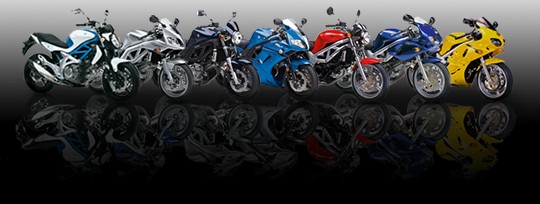 |
 |
Idle Banter For non SV and non bike related chat (and the odd bit of humour - but if any post isn't suitable it'll get deleted real quick). There's also a "U" rating so please respect this. Newbies can also say "hello" here too. There's also a "U" rating so please respect this. Newbies can also say "hello" here too. |
 |
|
|
Thread Tools |
|
|
#101 | |
|
Member
Join Date: Jun 2007
Location: South West London
Posts: 531
|
I have added a 3rd version of the shot above (Link). I processed the RAW file on the camera using the in built processing/retouching tools.
I think it has come out better than my gimp effort. Quote:
Thanks for your pointers Filipe. |
|
|
|

|
|
|
#102 |
|
Guest
Posts: n/a
|
Limitations of the digital lab.
As you can see from the images in this thread already, there's a lot you can do after the event, to tidy-up your images and recover ones that may not have turned out as expected. Reading this thread, seeing some of the fantastic shots you chaps have captured, and offering a few pointers along the way (tips hat to Filipe M. who has offered much more detailed help), had gotten me in to thinking about picking up the camera again. It's something I used to love, but I somehow lost my passion for it over the last few years. So, I've started to dig out some more of my kit, and going through what I've got and decided to offer this little nugget on extra bits, for those of you who have some christmas spends left over. Filters - much of what you can do with the sometimes bizarre and wonderful filters that have been available over the years, can now be done in your digital lab. Some however cannot. Skylight filter Most commonly used to protect the lens. It offers reasonably little in the way of difference to a photo, but can save you a lot of money by protecting your lens from getting scratched. Worth considering if you have expensive glass or are a clumsy so and so. Polarising filter These come in several types, circular and linear, Hoya do them that screw on to the end of the lens, or Cokin do the holder type variety. Have a google for what they do if you don't know, or wait for Filipe to expand ND (Neutral Density) filter Various styles and strengths, these simply reduce the amount of light coming through the lens, allowing longer exposure times. Or graduated ones, that allow you underexpose a bright sky for balance. Some cameras even have these built in now, although I'm not sure how, or how well, they work. Filipe, over to you. |

|
|
|
#103 |
|
Guest
Posts: n/a
|
It's here!!!
|

|
|
|
#104 | |||||||
|
Guest
Posts: n/a
|
Quote:
 Quote:
As a quick example, Adobe has released a preview / beta version of Lightroom 3.0, and already the processing differences are substantial in the image quality stakes. So much so that I'll probably be going over my "pick" shots again to see what more I can get from them. Quote:
Quote:
Quote:
Digital sensors are not as sensitive to UV light (they've got their own filtering layers), so they're usually seen as "cheap" neutral protection devices for the lens more expensive glass. On the negative side, they will increase the ammount of light travelling back and forth between the lens elements and the sensor, which might actually decrease contrast and create ghosting. Quote:
Polarising filters, through some black magic  , will make sure that all light rays hitting the lens will do so polarised in the same direction, removing stray reflections and increasing colour saturation. Want deep blue skies? Slap one in front of the lens and shoot at a 90º angle to the sun. Rotate the polariser until you get the desired effect. Careful though, it's not hard to get Disney-like colours. , will make sure that all light rays hitting the lens will do so polarised in the same direction, removing stray reflections and increasing colour saturation. Want deep blue skies? Slap one in front of the lens and shoot at a 90º angle to the sun. Rotate the polariser until you get the desired effect. Careful though, it's not hard to get Disney-like colours. DSLR users beware: you'll have to use circular polarisers (linear will make your autofocus system very un-cooperative - see I told you it was black magic!). All users beware: polarisers will eat light, forcing you to use much slower shutter speeds, or wider apertures (or increase ISO, but I wouldn't really recommend this - you'll be saturating colours and working with darker tones all around, and the higher the ISO, the less leeway your camera will have for dealing with this, and the noisier the image will be). Tripod territory! I'll try and come up with a couple of examples of use. Quote:
Yay! Now you smell of wee! Last edited by Filipe M.; 08-01-10 at 10:18 PM. |
|||||||

|
|
|
#105 | |
|
Guest
Posts: n/a
|
Quote:
But as technology improves, the ability to extract a better scan from the negative does too The other solution for avoiding white balance problems is to use black and white. If using digital, shoot in colour at the time as normal, then if you want later, use your raw editor to convert to B+W taking more or less of a contribution from each colour channel separately until it looks good. magic.  (film rather than digital, but you get the idea) For a classic look, then jack up the contrast something crazy - it'd normally unbalance the colours, but since we've gotten rid of them, who cares. Here's Peter's original image reworked: 
Last edited by cmsd2; 08-01-10 at 11:11 PM. |
|

|
|
|
#106 |
|
Guest
Posts: n/a
|
|

|
|
|
#107 | |||
|
Guest
Posts: n/a
|
Quote:
Quote:
Quote:
|
|||

|
|
|
#108 |
|
Guest
Posts: n/a
|
|

|
|
|
#109 |
|
Not Fizzwheel
Mega Poster
Join Date: Jul 2007
Location: Brum
Posts: 1,780
|
Guys, as you can see from Lilys posts our new toy arrived.
One thing we are keen to do is get a new lense as the 18-55 is good for simply taking basic pics, but we want something with a bit more range. Am I right in thinking that a 55-200 as a compliment to what we have would be a good start? Have found this one in Amazon and quite a decent price..... http://www.amazon.co.uk/Nikon-55-200.../dp/B000O161X0
__________________
My Bike Now Doesn't Have a Motor....Just Pedals!!!! Hovis RIP Buddy - 13/08/1975 - 03/10/2009 "Feckinnnn Unluckkeeeeeeee"  |
|
|

|
|
|
#110 |
|
Member
Mega Poster
Join Date: Aug 2005
Location: Tower Hamlets but with Shutters on the windows
Posts: 1,522
|
Drew you are right in your thinking, you might want to check out the 70-300 VR as well a bit more pricey but, might be worth getting the next step up. http://www.amazon.co.uk/Nikon-AF-S-7...2993061&sr=8-1
I have 55-200 and have got some amazing results, so much so that the standard 18-55 rarely comes out of the bag first now. .... this is an uncropped image only with standard lightroom processing.  Although I would say that I have now got to the point of recognizing the limitations of this lens, and would love to have a bit more flexibility with closer focusing. Last edited by anna; 08-01-10 at 11:33 PM. |
|
|

|
 |
|
|
 Similar Threads
Similar Threads
|
||||
| Thread | Thread Starter | Forum | Replies | Last Post |
| CV Examples | gruntygiggles | Idle Banter | 5 | 24-09-09 04:16 PM |
| AR Photography | Gordon B | 2008 Annual Rideout | 12 | 30-06-08 08:42 AM |
| Examples of k8 Colours please? | Griffo | Photos | 12 | 17-05-08 07:07 PM |
| Photography Kit | southy1978 | Idle Banter | 0 | 19-02-08 11:19 PM |
| Photography | localhost | Idle Banter | 16 | 22-01-06 07:59 PM |